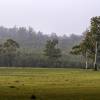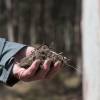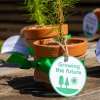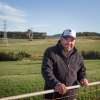
Family planting trees and improving their farmland to benefit future generations at Westerway
Posted 23 November 2021
Plantation Planning Managing trees Economic benefits and markets Carbon benefits Tree Alliance
Having already seen the benefits of planting trees at Westerway, Tom and Sarah Clark are excited by the opportunity to plant additional pines and leave their farms in the best possible condition for future generations to come.
Sarah and Tom planted a block of eucalypt nitens on their Ellendale block two years ago and were saddened to see the trees did not grow well in the area. They have since had the nitens cleared and logged so that the area can be replanted with the more durable radiata pines.
“We want to show that it is possible to re-plant trees in areas where previous plantations haven’t done so well. In this instance, we are planting the trees in between the stumps of the ex-nitens, and we plan on planting an entire block of radiata pine which we can invest in for future profit,” explains Sarah.
“We will leave the front part of the block to go back to paddocks as it’s productive ground and we can incorporate some shelterbelts there too. Again, we’re hoping to show that you can still return the area back to paddock after harvesting trees.”

Strategically planting trees to maximise profit and productivity
By replacing the failed nitens with pines on the steeper grounds, Sarah and Tom are maximising the use of these areas that cannot be utilised for crops and livestock.
“We are ultimately making sure that whoever we pass this land on to next, we are handing it over in a better condition than what it was in when we bought it. So, we are thinking and planning for as long term as possible, as we have seen first-hand the benefits of established shelterbelts in Westerway,” explains Sarah.

Trees are regenerating the land
Sarah also notes the added benefits that trees have on improving the farm’s aesthetic.
“From our house we can look back to the block where we planted trees ten years ago and we can now see them on the skyline which adds to the view. When we take the kids for walks in the afternoon through the trees and bush it is a lot nicer than walking through bare paddocks,” adds Sarah.
Sarah and Tom say that they are excited to see the benefits of being involved in the demonstration site project.
“Being involved in Private Forests Tasmania’s demonstration site project was appealing to us because we are quite new to planting trees and could see the potential for useful shelterbelts which can be commercially harvested. Tom and I are always looking to learn new things and see how others are harnessing the latest industry innovations. We are really hoping to inspire other farm owners to plant more trees not only for the environmental benefits, but for the future of their farms”.
Share this Article
Latest Articles
-

04 November 2025
Prioritising outcomes for Tasmania's private forest growers in 2024-25
-

20 October 2025
Tasmanian High Soil Carbon Landscapes project
-

17 September 2025
Celebrating excellence at the Tasmanian Timber Awards
Archives
- ActivAcre hits milestone, calls for more farmers to get on board
- Napier's leading the way in sustainable forestry and carbon-neutral farming
- Sound science needed to assess carbon impacts of timber harvesting
- Newly appointed TFFPN Board of Directors
- Graduate Certificate of Forestry Scholarship
- Forestry Australia Mentoring Program 2025
- Forest Industry Roundtable planning for the long term
- Eagle Management Constraint Period extended
- Successful private native forest management celebrated
- $15 million investment in new ship loader to boost Bell Bay's forestry exports
- Standing with Tasmania's forestry industry: buy local
- TFPA: Tasmanian Freight Equalisation Scheme needs a ground-up review
- AFCA Gala Dinner celebrates industry excellence
- Fire permits now required Statewide
- Forest leaders hone skills in sustainable native regrowth management
- Tasmanian forests and the carbon market: Barriers and opportunities
- What the 2024-25 Tasmanian Budget means for forestry
- Spring is the time for fuel reduction burning
- Primed for Growth: A situation analysis of the Tasmanian Forest and Wood Products Sector
- Audit requirements cut for low-risk plantation projects
- Guidance and support for landowners after damaging winds
- Forestry Australia welcomes further definition of active forest management
- Farm & Forest Mapper Tool highlighted at Rural Youth Tasmania's Young Farmer of the Year competition
- Senate Select Committee inquiry into the Tasmanian Freight Equalisation Scheme
- Timberlink announces new wood composite products brand
- Newly developed protocol a vital tool for safeguarding forestry industry
- Red Hot Tips: Fire management for Tassie farmers
- Bioenergy: Fuelling industries with trees
- Harvesting trees: What you need to know
- Shelterbelts: How are they contributing to farm systems?
- Infill plantings and remnant vegetation: Why biodiversity depends on a thriving understory
- Plantation planning: The key to a successful plantation
- Exciting interactive forestry knowledge hub launched
- $450,000 farm forestry grant recipients revealed


